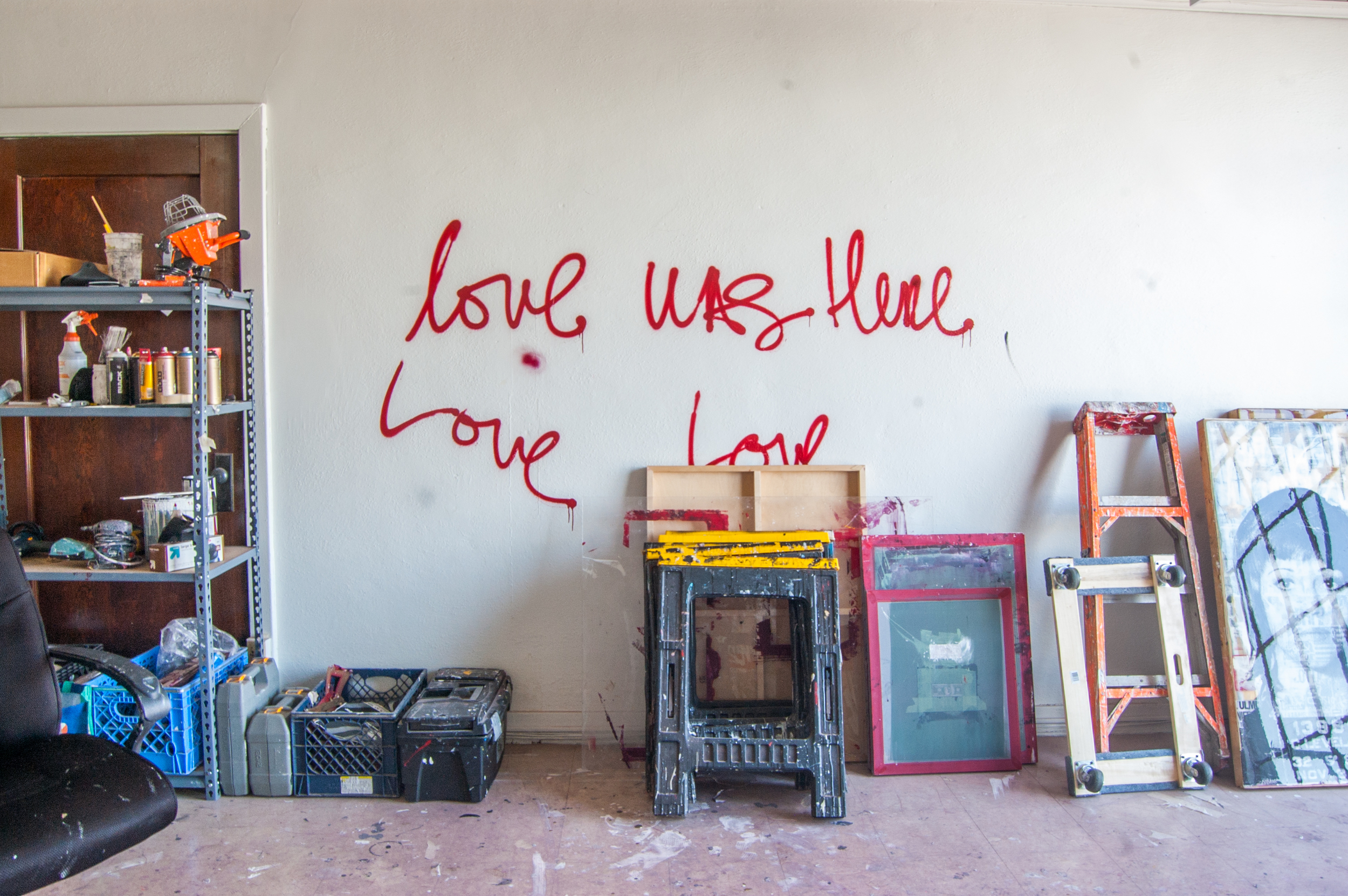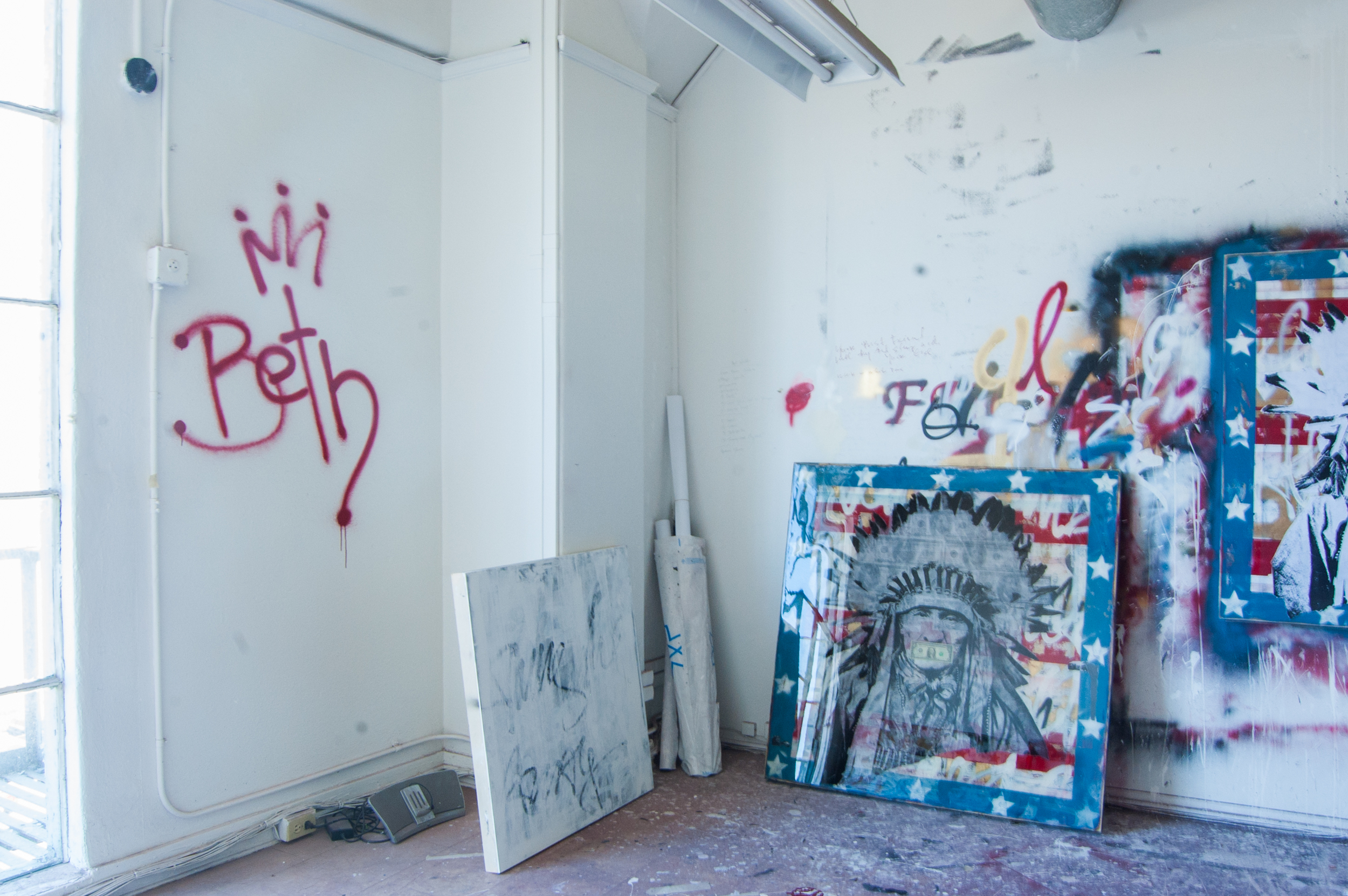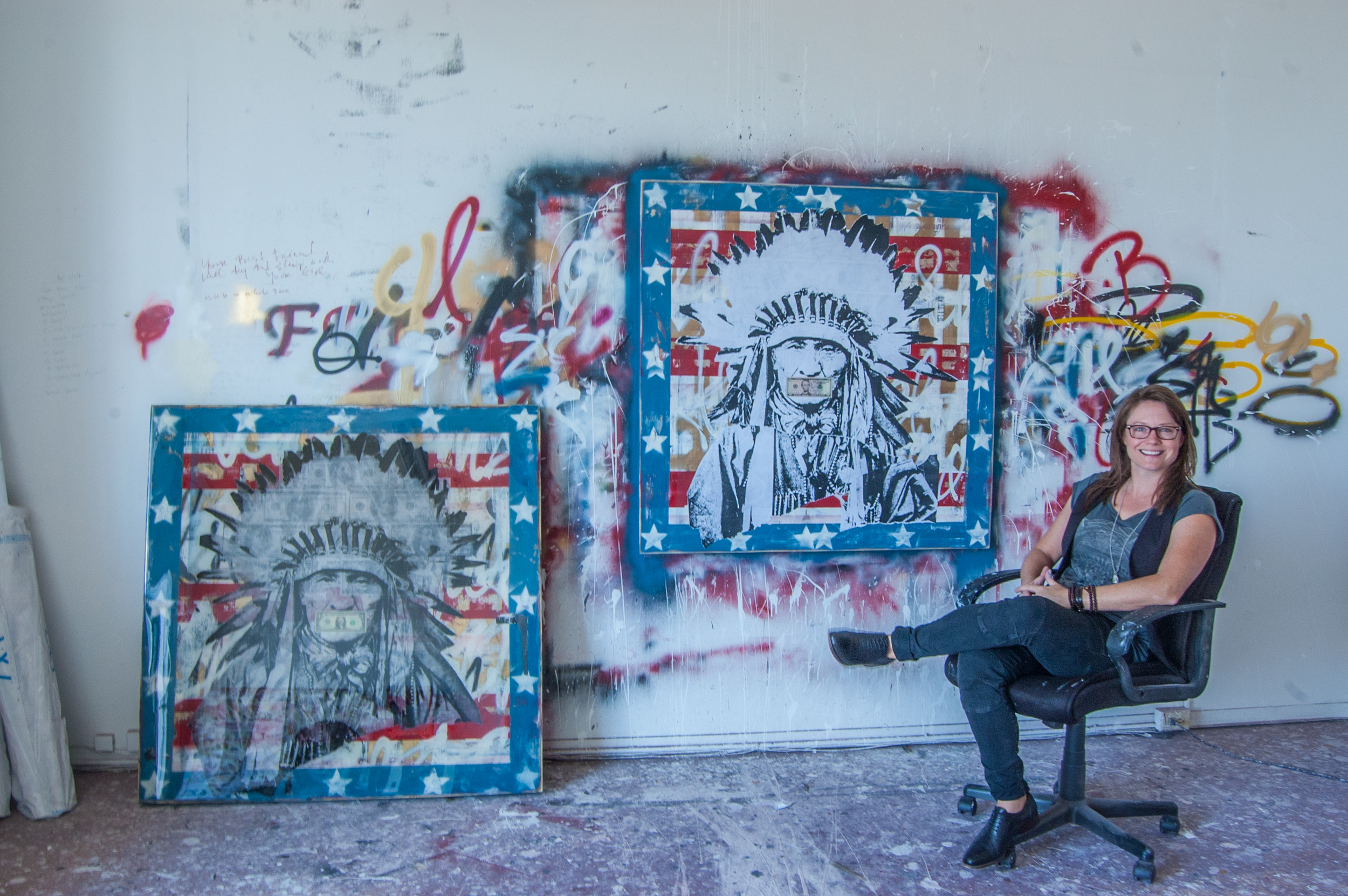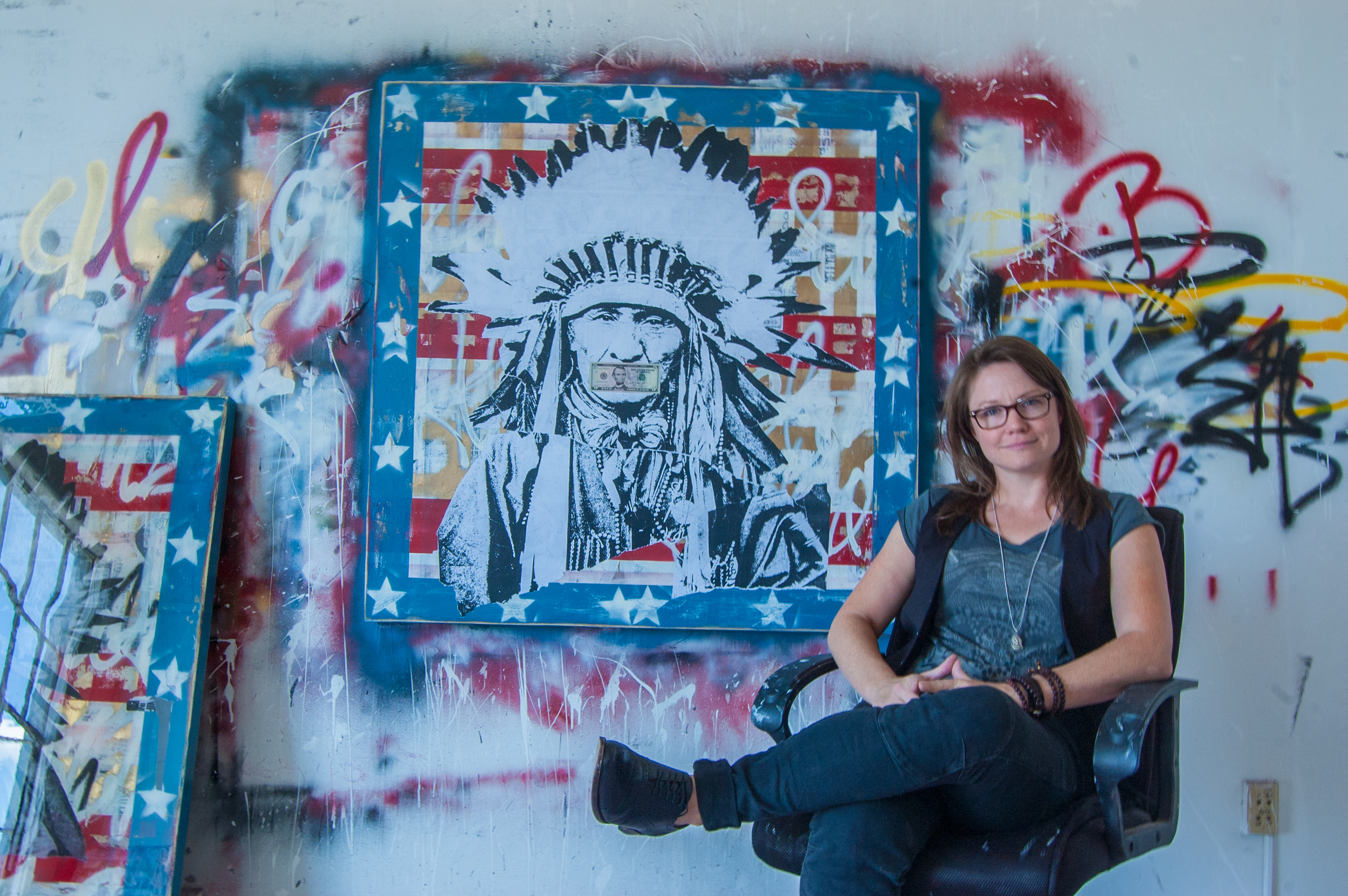



It's been a while since we've been Inside the Artist's Studio, and we figured there was nobody better to help us break the radio silence than Art Unified artist Ashleigh Sumner. Her vibrant style is impossible to speak over in all its defiant and unapologetic glory. Sumner's mixed-media work employs the use of spray paint, resin and pop culture imagery, simultaneously evoking a sense of both longing nostalgia and a fresh beginning. Her vibrant reinterpretation of these iconic images lends to viewers a sense of epiphany, like the restoration of an old fable, whose gritty truths have resurfaced in time for another round of storytelling. Read on to see what this Arts District painter and creative entrepreneur had to say about recycling Marilyn Monroe, why she loves Patti Smith, and her recent work with the ESPYs.
"Do what inspires you, for no result at all. Forget the result. That’s what I would say to you. Forget the result and just create."
Art Unified: Let’s start off with you telling me about your background - where you grew up, what you studied…
Ashleigh Sumner: I’m originally from North Carolina, and I moved out West about 10 years ago. My background is in theater arts, and that’s what I studied back South. That’s what I moved out here for. I’ve always painted since I was a kid. I took some art classes in college, and my art teacher begged me to study art in college. But, you know, coming from the South, it wasn’t like New York where you see museums, galleries, artists and the career of an artist. I didn’t really know any painters growing up. I loved theater, and I could turn on the TV and see plenty of actors and what they were doing. I could comprehend that. But actually making a living from art wasn’t in my consciousness at al.
So I moved out here, and started working as an assistant director for a television and theater director, Peter H. Huntz. I learned a tremendous amount, acted for a long time until recently. I did a lot of shows, recurred on a show on NBC. The last thing I did was a guest star on Orange Is the New Black. I’ve done a lot of queer film, with a lot of success there.
It wasn’t until the actor’s strike - where there was no work and no auditioning, the industry just shut down - that I started to pick up my brushes. I started to put out what I was working on through Facebook. I posted my first painting and it sold. That was the beginning. From there, I guess that was five years ago now, it has snowballed. I started to work with galleries, I started to work more, I started to work with commissions. Pretty soon, I was able to quit my job with the director. So that’s my background.
AU: When you first came to Los Angeles, you mentioned that you didn’t have creative culture around you in the South. Did you find it easy to launch yourself into it once you arrived in Los Angeles?
AS: I love theater arts, so I always had that outlet. I started to really get drawn back into painting because, as an actor, that’s a collaborative art. You have very little control. I could want to play Juliet (I don’t really) and I’ve got to wait for somebody to cast me in it, there’s got to be production, you’ll be waiting on XYZ. I can go paint whatever I want, whenever I want, however I want it. No one can edit it, no one can change it. It’s mine. I will always have that catharsis, which doesn’t happen all the time as an actor. Now, whether or not it sells, that’s a whole other thing. But who the fuck cares? At least I got to create it.
I started to get drawn to that because of the acting in LA. It helped balance that. And then I discovered downtown before it really blew up. And I loved it. I love the industrial wilderness of it. I love that there is an energy that was very authentic. When you drive through Skid Row on a daily basis, a lot of bullshit that we all get tied into, melts away. My work really started to shift and change because of this area, the street art, the distressed, gritty beauty of it all. It was a direct correlation with what I do. The more fucked up and gritty it is, the more I love it.
AU: Can you describe your style evolution? What did you originally start out painting and how does it compare with what you’re doing now?
AS: Oh, it’s very different. It was all abstract. Still on wood and bamboo, but it was purely color. There was no photo imagery. And I painted with knives. It was all scraping. No spray paint. Eventually, something shifted. You start to see other artists, something clicks in your brain, and I started to move to imagery. And it worked perfectly with the resin. Elements started to bleed through the work, which created this whole other level of mixed media. It’s about to evolve again. I want to start bringing in more of an abstract feel, but bringing in screen printing. That’s the plan. Let’s see if I can execute it.
"I discovered downtown and I loved it. I love the industrial wilderness of it. I love that there is an energy that was very authentic. When you drive through Skid Row on a daily basis, a lot of bullshit that we all get tied into, melts away."
AU: In your artwork, you’re really drawn to figures of Americana and American pop culture figures. What draws you to that sort of imagery?
AS: I think… I don’t know. Sometimes, I think it has to do with what, politically, behind that imagery. I like taking those images and giving them a twist to make commentary on a modern day issue. I’ve been using Marilyn Monroe a lot lately, with money over her mouth. She’s such an iconic symbol of beauty, who has been reproduced and reproduced in art, mostly by men. As a woman, when I see Marilyn Monroe, she’s beautiful but in a way that beauty ultimately killed her. There’s a price that women pay in beauty and our Hollywood image of beauty. There’s a cost to all of that. So there’s that symbol of it that I like to use and then twist it, as a woman. I think it’s different from when men are reproducing images of Marilyn Monroe. It can kind of be one-dimensional in that, here’s this beautiful woman. There’s so much more there.
AU: When you first started out, you said that your first painting sold immediately. Was that in a physical space or in a digital space?
AS: It sold on Facebook. And this was when Facebook first started. Your grandmother wasn’t on it yet. It had just started and it sold.
AU: So how have you found the aspect of social media in developing your artist career?
AS: Social media has helped. You have your artist website, and the social media part of that really opens the world up to the process and how you think, through articles that you post or the process that you’re going through. I think that some artists use it to promote themselves in a whole other way… selfies and things, I’m not big on that. To each their own, God bless. But I think it lends itself to letting people know the artist as a person.
"It’s studio time, working your ass off, growing and flopping and flying. Working your way through. It’s a fight. Until you get to your breakthrough… I think that’s the bottom line. It starts in the studio."
AU: Do you think that has played a lot more into the art-buying process?
AS: Yes. We’re all buyers of some sort. We all are drawn to musicians, actors, whoever because we’re also thinking of who they are as people. You know, I think of Patti Smith - I love her music. But I also love how she thinks, what she has to say. I love knowing what she’s interested in. So I think when you can build that love - because your artwork, when you think about it, is going to be something that somebody is going to see every single day - so if they have a positive relationship with you or a positive idea of who you are, that makes it even better. Some people love Warhol because of who he was, or Basquiat, or Barbara Kruger because of her political stance. It adds to that.
How do you reconcile this personality building in social media with on-the-ground connections?
AS: I think that social media can form a trap for artists versus on the ground. For artists, authenticity is very important. On the ground people will always respond to authenticity in art. The trap with social media or marketing is that you can start to try to market this idea that you would like people to think of your persona. It might work for some artists. But don’t move away from the authentic.
Yes, [social media] is important. But at the end of the day, if you can’t act then you can’t act. It doesn’t matter how many parties you go to. At the end of the day, it’s about your work. Hopefully it’s good and it sells. I don’t think [social media] is going to make your career. I think it’s studio time, working your ass off, growing and flopping and flying. Working your way through. It’s a fight. Until you get to your breakthrough… I think that’s the bottom line. It starts in the studio. You can post as much as you want. But if you’re not connecting with your work, then people won’t connect with you.
AU: Your work was recently on display at the ESPYs. How did that all unfold?
AS: I got lucky. You want to talk about authentic relationships? Everything is about relationships. I did a fundraiser for the Human Rights Campaign and donated a piece. The person who acquired that piece manages the Nokia Live - now the Microsoft - theater. He said, ‘I love your work, and we want to add artwork to the VIP lounge. Can you bring over some artwork?’ Since it’s a major music venue, I did a lot of musicians. Then the ESPYs came around, and he asked me to do a piece for the athlete’s lounge. That’s how I was approached about it. Then, it was like, what do I make? I finally settled on Jordan. Just a standard of excellence.
"It’s a marathon, not a sprint."
AU: What would you say to a young creative living in this city or cities like this, who are overwhelmed by the competitor pool?
AS: Picasso did everybody a disservice when he said, ‘Great artists steal’. Because then you’re chasing something. You can be inspired. At the end of the day, though, don’t compare yourself. That’s the train straight to cuckooville. Find your voice. That’s just done through work, life, evolution. Do what inspires you, for no result at all. Forget the result. That’s what I would say to you. Forget the result and just create.
AU: You mentioned that you have a clothing line. Can you talk a little bit about that?
AS: Yes! I have a clothing line with two other creative partners, and it’s sort of come out of the art. We got it up and running, and then my art career started to get super busy. We’ve come back to it, and we're bringing more items to the table. It’s another form of expression and creativity. Have I ever sewn a day in my life? No. But I work with someone who has. Mark E. Walker, a dear friend and Arts District guy, who has had a few other lines and other entrepreneur experiences as well. My other partner is Gia Esquival, who is now in San Francisco, is a brilliant marketer and graphic designer. She branded Gucci’s online presence, she did British Airways when they first started online. She’s great. It’s another outlet. It’s women’s streetwear and it’s called FIERS. We do everything here in L.A., we make our own patterns, pick out our own fabric down here. We’re gender neutral in a lot of ways, and we just want to empower women. We align ourselves with non-profits and organizations that share that wonderful feminist mindset.
AU: Is this tied to your ‘Love Was Here’ project?
AS: Yes. ‘Love Was Here’ is from this organization called ‘Break the Silence’ which is a great organization that talks about breaking the homophobic silence that exists in sports. This is a special campaign that’s also tied with the WNBA and members of the Women’s World Cup soccer tournament. They’re going to be launching this in the next coming weeks. We made the shirts for them, and we made the design and the tag. These were being sold at the World Cup and will be sold at the upcoming WBNA All Star Game.*
AU: We talked about a lot of your projects. What is juggling that creative workload like? Do you just never sleep?
AS: You do get up early. Some days you commit just to this and just to that. It’s a challenge. But you know, I think, it’s similar to being a musician. If you can read music, then you can play the trumpet, you can play the guitar. I think creatives sometimes do all of that. Yeah, dude, I’m not going to lie… it’s something.
"Picasso did everybody a disservice when he said, ‘Great artists steal’. Because then you’re chasing something."
AU: Do you ever the feel to step away from your work and replenish your creative well?
AS: With painting, yeah, I think you have to step away and fill back up. It’s exhausting. Otherwise you’re just creating shit. Shit that looks tired. And then you’re just wasting supplies.
AU: How do you step away?
AS: That’s usually when I start going to museums or read or watch films. I try to get inspired. Inspiration comes and goes. It can be elusive. The older you get, you realize when it’s there and when it’s not and how to go fill back up. It’s a strategy in and of itself.
AU: What is the favorite piece you’ve ever received about being an artist or a creative?
It’s a marathon, not a sprint.
*To learn more about the 'Love Was Here' project, visit the FIERS website.
